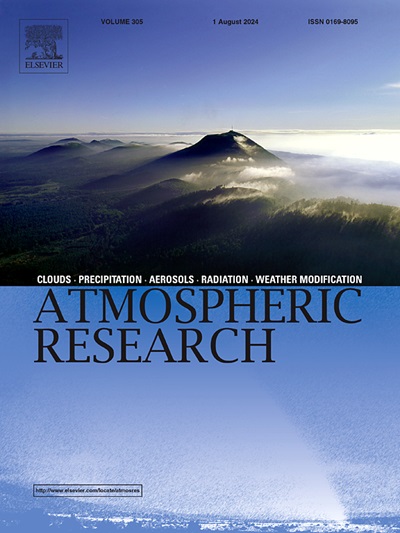Ensemble versus deterministic lightning forecast performance at a convective scale over Indian region
IF 4.5
2区 地球科学
Q1 METEOROLOGY & ATMOSPHERIC SCIENCES
引用次数: 0
Abstract
The present study quantifies the improvement achieved in lightning forecast skill of the NCMRWF regional ensemble prediction system (NEPS-R) compared to its deterministic counterpart (CNTL). The lightning forecasts over study regions of East and Northeast India (ENEI) and Peninsular India (PI) during the pre-monsoon season and Central-East and Northeast India (CENEI) during the monsoon season have been verified using lightning observations from the Indian Institute of Tropical Meteorology (IITM) Lightning Detection Network (LDN). The persisting systematic negative bias in deterministic and EPS-based forecasts of the ensemble mean (EnsMean) and ensemble maximum (EnsMax) indicate the lack of spread among the members, supported by the low values of ensemble spread over all the study regions. EnsMean has the lowest RMSE, with a decrease in error ranging from 0.8 % to 2.18 % compared to CNTL. Categorical skill scores indicate that the EPS-based forecasts (EnsMean and EnsMax) are more skillful than the deterministic forecast at all thresholds and lead times. Further, Fractions Skill Score (FSS) establishes the superiority of the ensemble forecasts over the deterministic forecasts, where for threshold >1, EnsMean is skillful at comparatively smaller neighborhood sizes (ENEI and PI ∼68 km; CENEI ∼36 km for day-1) than CNTL (ENEI-116 km; PI-196 km; CENEI-68 km). EnsMax at higher thresholds (>5 and >10) is skillful at lesser neighborhood sizes ranging from 116 to 276 km compared to CNTL (>401 km) for day-1. Hence, skillful re-scaled EPS forecasts based on FSS could provide better guidance for the forecasters. The Continuous Ranked Probability Score of EPS forecasts is lower by around 9 % than the Mean Absolute Error of CNTL forecasts, and the ROC of EPS shows better discrimination of events and non-events compared to CNTL. These highlight the merits of using an EPS over a deterministic system for forecasting a field of high spatial variability, like lightning, and thereby, the use of vast computational resources to run a convective scale EPS is justified.
印度地区对流尺度上的集合与确定性闪电预报性能对比
本研究量化了 NCMRWF 区域集合预报系统(NEPS-R)与其确定性对应系统(CNTL)相比在闪电预报技能方面所取得的改进。利用印度热带气象研究所(IITM)闪电探测网络(LDN)的闪电观测数据,验证了季风季节前印度东部和东北部(ENEI)和印度半岛(PI)以及季风季节印度中东部和东北部(CENEI)研究区域的闪电预报。在确定性和基于 EPS 的集合平均值(EnsMean)和集合最大值(EnsMax)预报中持续存在系统性负偏差,这表明各成员之间缺乏扩散,所有研究区域的集合扩散值都很低。与 CNTL 相比,EnsMean 的均方根误差最小,误差减少了 0.8 % 到 2.18 %。分类技能得分表明,在所有临界值和提前期,基于 EPS 的预报(EnsMean 和 EnsMax)都比确定性预报更有技能。此外,分数技能得分(FSS)确定了集合预报优于确定性预报,在阈值>1时,EnsMean在相对较小的邻域大小(ENEI和PI∼68 km;CENEI∼36 km,第1天)比CNTL(ENEI-116 km;PI-196 km;CENEI-68 km)更有技能。与 CNTL(401 km)相比,阈值较高(5 和 10)的 EnsMax 在邻域大小(116 至 276 km)较小的情况下对日-1 比较熟练。因此,基于 FSS 的高技能再缩放 EPS 预报可为预报员提供更好的指导。EPS 预报的连续排列概率得分比 CNTL 预报的平均绝对误差低约 9%,与 CNTL 相比,EPS 的 ROC 显示出更好的事件和非事件分辨能力。这些都凸显了在预报雷电等空间变化大的领域时,使用 EPS 比使用确定性系统更有优势,因此,使用大量计算资源来运行对流尺度的 EPS 是合理的。
本文章由计算机程序翻译,如有差异,请以英文原文为准。
求助全文
约1分钟内获得全文
求助全文
来源期刊

Atmospheric Research
地学-气象与大气科学
CiteScore
9.40
自引率
10.90%
发文量
460
审稿时长
47 days
期刊介绍:
The journal publishes scientific papers (research papers, review articles, letters and notes) dealing with the part of the atmosphere where meteorological events occur. Attention is given to all processes extending from the earth surface to the tropopause, but special emphasis continues to be devoted to the physics of clouds, mesoscale meteorology and air pollution, i.e. atmospheric aerosols; microphysical processes; cloud dynamics and thermodynamics; numerical simulation, climatology, climate change and weather modification.
 求助内容:
求助内容: 应助结果提醒方式:
应助结果提醒方式:


